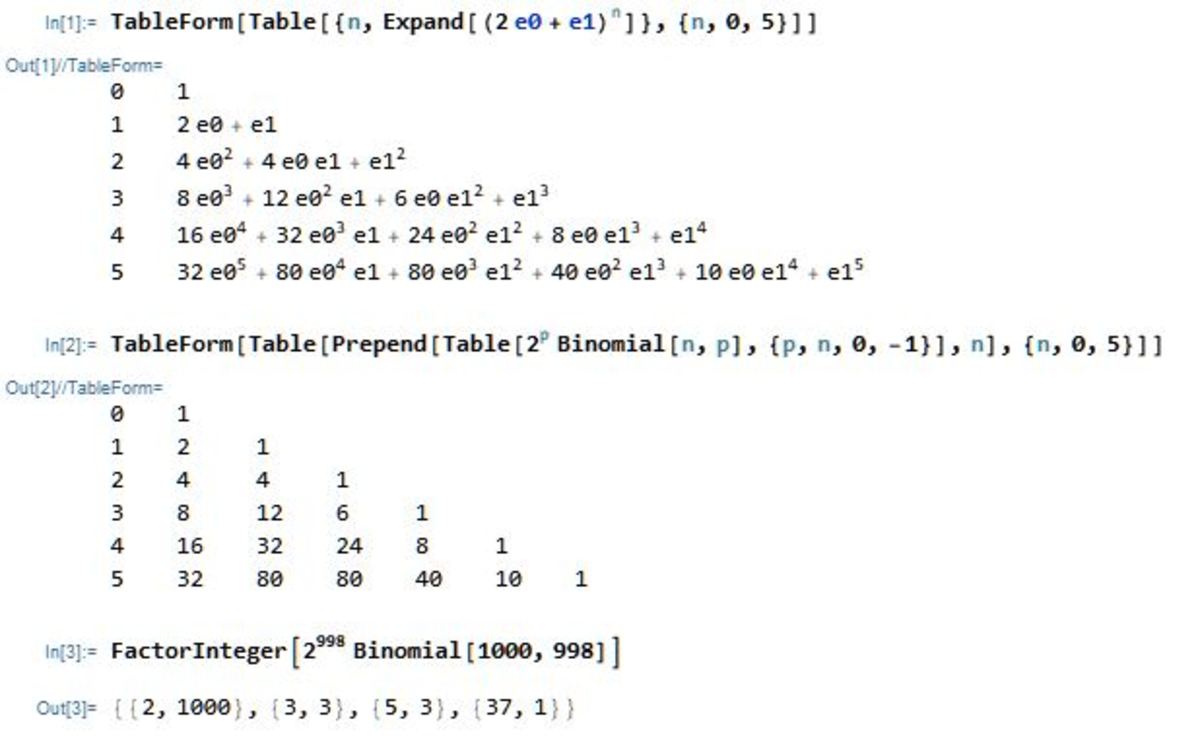Pascal's n-Cube Triangle
Let us define an -cube as a closed, convex figure in an -dimensional space whose line segments are perpendicular to one another and are the same length. Some examples include a point ( -cube), a line ( -cube), a square ( -cube), and a cube ( -cube).
Now, a -cube (point) has point on its boundary; a -cube (line) has points and line on its boundary; a -cube (square) has points, lines, and square on its boundary; and a -cube (cube) has points, lines, squares, and cube on its boundary. These numbers can be placed in a Pascal-like triangle, where each number is the sum of the number above and to the left of it and twice the number above and to the right of it. (For example, the in the fourth row is , because is the number above and to the left of it and is the number above and to the right of it.)
We can extend this triangle to predict the number of elements on the boundary of a -cube (tesseract): points, edges, squares, cubes, and tessaract.
Find an explicit formula that can calculate any number in the triangle, and use it to find the exponent of the greatest power of that evenly divides the total number of squares on the boundary of a -cube.
Note : This problem does not require a programming solution.
The answer is 1000.
This section requires Javascript.
You are seeing this because something didn't load right. We suggest you, (a) try
refreshing the page, (b) enabling javascript if it is disabled on your browser and,
finally, (c)
loading the
non-javascript version of this page
. We're sorry about the hassle.

The number of m -cube elements on the boundary of an n -cube is defined as f ( n , m ) = 2 n − m ( m n ) (see inductive proof below). Therefore, the number of squares on the boundary of a 1 0 0 0 -cube would be when m = 2 and n = 1 0 0 0 , and would be defined as:
f ( 1 0 0 0 , 2 )
= 2 1 0 0 0 − 2 ( 2 1 0 0 0 )
= 2 9 9 8 ( 1 0 0 0 − 2 ) ! ⋅ 2 ! 1 0 0 0 !
= 2 9 9 8 9 9 8 ! ⋅ 2 ! 1 0 0 0 !
= 2 9 9 8 2 1 0 0 0 ⋅ 9 9 9
= 2 9 9 8 2 1 0 3 ⋅ 9 9 9
= 2 9 9 8 2 2 3 ⋅ 5 3 ⋅ 9 9 9
= 2 9 9 8 + 3 − 1 ⋅ 5 3 ⋅ 9 9 9
= 2 1 0 0 0 ⋅ 5 3 ⋅ 9 9 9
Since 5 3 ⋅ 9 9 9 is not divisible by 2 , the greatest power of 2 that evenly divides the total number of squares on the boundary of a 1 0 0 0 -cube is 2 1 0 0 0 , and its exponent is 1 0 0 0 .
Inductive Proof:
Assuming f ( n , m ) = 2 n − m ( m n ) is true, it can be shown that f ( n + 1 , m ) = f ( n , m − 1 ) + 2 f ( n , m ) = 2 n + 1 − m ( m n + 1 ) as follows:
f ( n + 1 , m )
= f ( n , m − 1 ) + 2 f ( n , m )
= 2 n − ( m − 1 ) ( m − 1 n ) + 2 ⋅ 2 n − m ( m n )
= 2 n + 1 − m ( n − ( m − 1 ) ) ! ( m − 1 ) ! n ! + 2 n + 1 − m ( n − m ) ! m ! n !
= 2 n + 1 − m [ ( n + 1 − m ) ! ( m − 1 ) ! n ! + ( n − m ) ! m ! n ! ]
= 2 n + 1 − m [ ( n + 1 − m ) ! m ( m − 1 ) ! n ! m + ( n + 1 − m ) ( n − m ) ! m ! n ! ( n + 1 − m ) ]
= 2 n + 1 − m [ ( n + 1 − m ) ! m ! n ! m + ( n + 1 − m ) ! m ! n ! ( n + 1 − m ) ]
= 2 n + 1 − m ( n + 1 − m ) ! m ! n ! ( m + n + 1 − m )
= 2 n + 1 − m ( n + 1 − m ) ! m ! n ! ( n + 1 )
= 2 n + 1 − m ( n + 1 − m ) ! m ! ( n + 1 ) !
= 2 n + 1 − m ( m n + 1 )
Therefore, by inductive proof the number of m -cube elements on the boundary of an n -cube is defined as f ( n , m ) = 2 n − m ( m n ) .